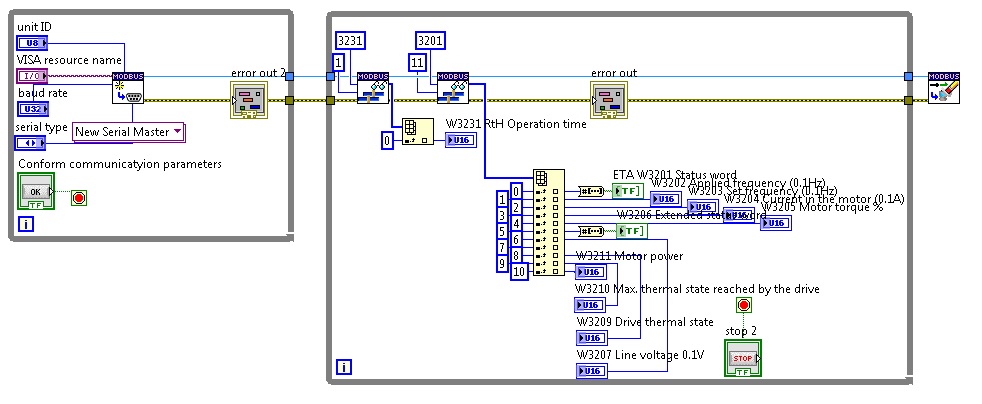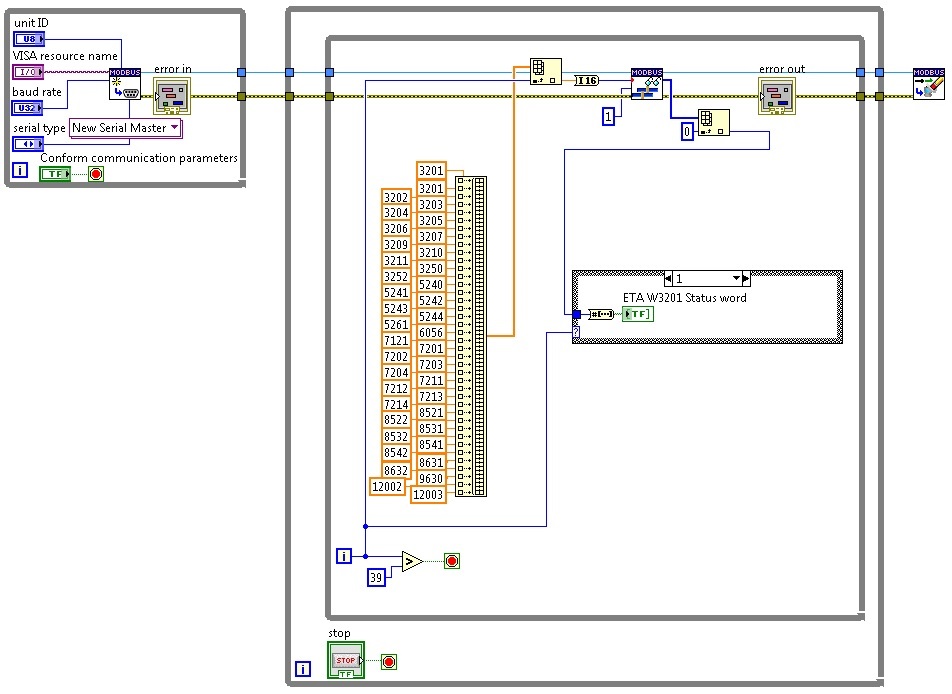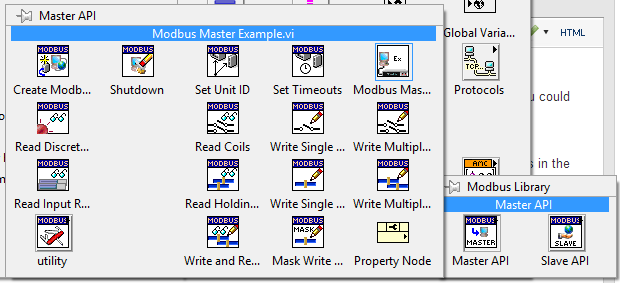- Subscribe to RSS Feed
- Mark Topic as New
- Mark Topic as Read
- Float this Topic for Current User
- Bookmark
- Subscribe
- Mute
- Printer Friendly Page
Reading array of holding address using RTU Modbus
03-05-2014 08:23 AM
- Mark as New
- Bookmark
- Subscribe
- Mute
- Subscribe to RSS Feed
- Permalink
- Report to a Moderator
Hello!
I am building a user interface to monitor and control Altivar31 invertor by RTU Modbus using Labview 2013 and Labview Modbus API https://decibel.ni.com/content/docs/DOC-30140.
At this moment I have successfully read about 11 variables which are going one by another (W3201-W3211)
I should read more variables (about 30). (3231, 3250, 3252, 5240, 5241, 5242, 5243, 5244, 5261, 6056, 7121, 7201, 7202, 7203, 7204, 7211, 7212, 7213, 7214, 8521, 8522, 8531, 8532, 8541, 8542, 8631, 8632, 9630, 12002, 12003)
To do this at the moment I am putting new Read Holding Registers VIs. It takes a lot of time and the program structure becomes overloaded.
Is it possible to use only one Read Holding Registers VI giving it an array of addresses which I should read?
How I can achieve it?
Thank you!
PS: My project is in attachment.
03-07-2014 01:17 AM
- Mark as New
- Bookmark
- Subscribe
- Mute
- Subscribe to RSS Feed
- Permalink
- Report to a Moderator
I have modified my application.
Now I build matrix of address values sending it to Modbus Read Holding Registers VI and sending result to indicators trough case structure. Data reading part of the program works in a double while loop.
Program structure became simplier to understand, but it works wery slow - data update of all indicators (variables) takes up to 1200 ms.
Previous version of the program was working much faster and delay was not noticeable.
Are there some options to increase performanse of the program?
The previous version of the program:

The new version of the program:

03-11-2014 06:48 PM
- Mark as New
- Bookmark
- Subscribe
- Mute
- Subscribe to RSS Feed
- Permalink
- Report to a Moderator
Hi ifku,
NI Labs as a whole is not monitored. Instead, each tool posted (like the Modbus library) has a discussion page associated with it. I happened to look at the recent content section, but no users are notified by your posts here. As such, I would appreciate it if you could direct any future posts to either the modbus library discussion page (for use of the libraries, or issues with the library) or to the standard NI forums (for other questions).
In your case, I have a few points of feedback:
- First, on the right, I notice that you have a while loop waiting for a boolean to configure the master. However, this code is executing very fast and is actually creating many masters the way you have written it. A better option would be to just put the controls in the whole loop (not the VI), and only call the init function once. A better option still is demonstrated in my example, located here in the palette:

- Second, the right side. I think there are definitely a few optimizations you can perform. The first is reading data in bulk using the read holding registers function with a "number of inputs" other than 1. For example, you can read 3201-3250 with a single read (starting element 3201, length 50) and index out the elements you need.
- Then, you can use a for loop to go through a set of these ranges.
- Finally, you can simplify your UI through the use of a cluster.
I've attached an example of this. I think your performance difficulties come from the sequential single-element requests. The example I attached is more complex, but should help you achieve higher performance.
Thanks,
Daniel
